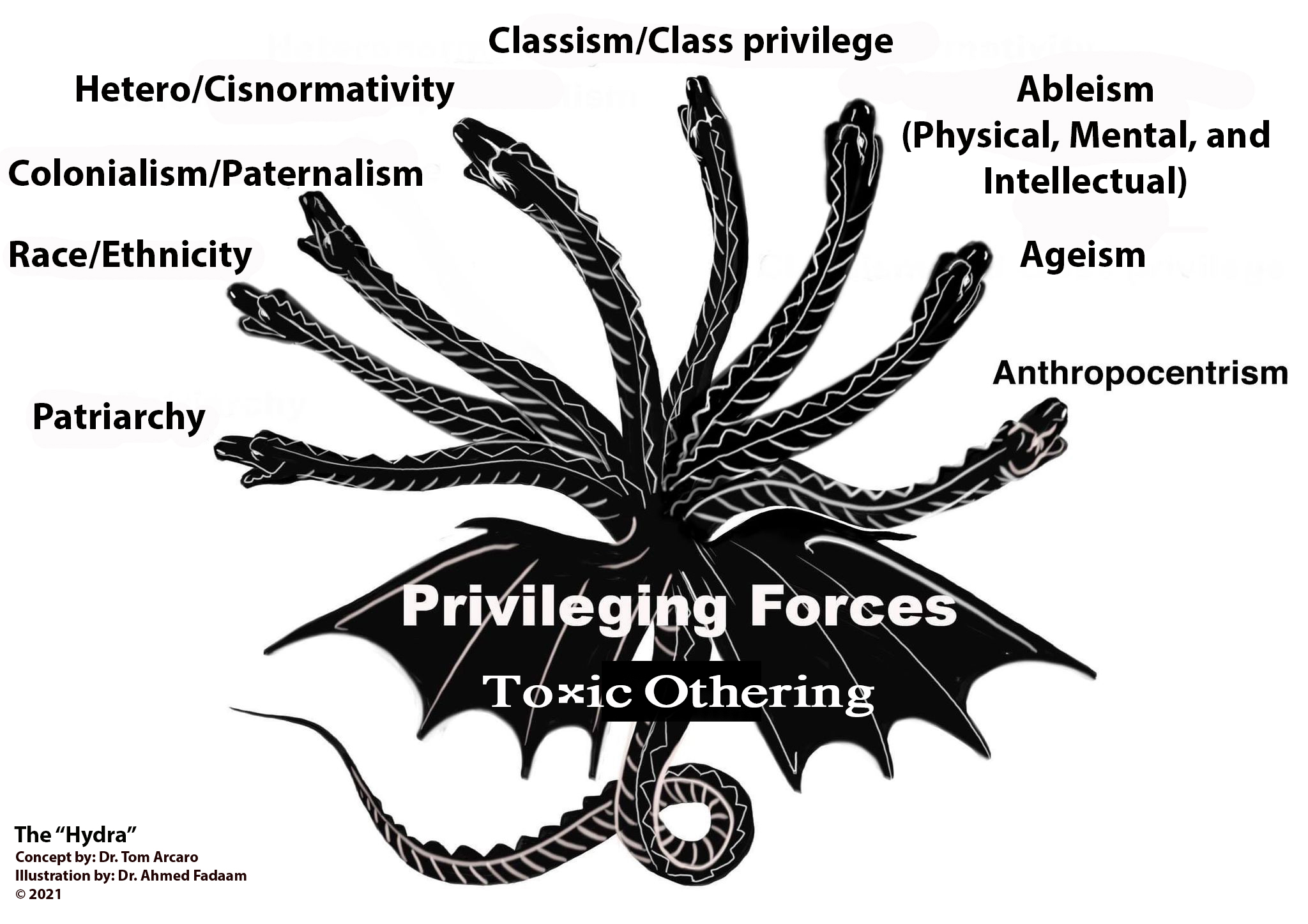“Until the lion learns to speak, tales of hunting will always favor the hunter.”
Applying Critical Hydra Theory on Tuesday morning
Paris, 2021
Later this fall I will take part in a panel session at the 6th meeting of the International Humanitarian Studies Association (IHSA) meeting in Paris. As co-organizer of this panel, I will have the duty of opening our session with some remarks intended to frame our discussions related to the panel’s theme “Privileging Forces in the Humanitarian System: Power and Marginalization”. It seems fitting that this next phase of talking about what I have called ‘critical Hydra theory’ will take place in the context of a conference since this conceptual journey had its beginning at the ALNAP meeting in Berlin in 2019.
My goal will be to introduce the Hydra model and urge those listening to embrace this conceptual tool. Though having a longer history, the commonly heard phrase, “I suppose it is tempting, if the only tool you have is a hammer, to treat everything as if it were a nail” is attributed to American psychologist Abraham Maslow. Although disparaged as cognitive bias, I will argue that in this case the tool that I will encourage people to use has broad application, especially regarding the topic for our panel. The Hydra model is all about shining a light on ‘power and marginalization.’
Critical Hydra Theory
Specifically, I will be explaining ‘Critical Hydra Theory’ (CHT), pointing out that the phrase has its origins in ‘Critical Race Theory‘ (CRT) but that it is more comprehensive, interrogating not just race and ethnicity but all of the privileging forces which have historically served to marginalize the majority of humans, both past and present. Like Critical Race Theory, this new perspective has a heavy emphasis on history, the phenomena of intersectionality, and how each of the privileging forces are structured into cultural systems. Using the illustration of the Hydra, I’ll briefly introduce and explain each head.
Critical Hydra Theory is a powerful metaphor for engaging critically with intersectionality and reflexively with privilege; is a novel packaging of an old idea, namely that in many -perhaps most- cases those in power will seek to normalize and justify the marginalization of the ‘other’. These processes of normalization and justification serve to weave marginalization into the very fabric of each culture leading to various levels of ‘false consciousness.’ Both those being marginalized and those doing the marginalization may come believe the falsehood that, for example, women are inferior to men or that ‘white’ people are superior to non-white people.
Critical Hydra Theory demands taking a very controversial stance, questioning how power has been misused in the formation of nearly all cultural institutions, but especially those of family, religion, politics, law, education, and the media. Embracing CHT means interrogating all cultural assumptions, norms, policies, laws, and structures which support toxic othering in any form.
I am reminded -and cautioned by -the phrase from Hermann Hesse, “The bird fights its way out of the egg. The egg is the world. Who would be born must first destroy a world.” Acting on lessons learned from CHT means being sober to the fact that cultures are integrated and complex fabrics, and that pulling on one string may unravel essential parts of the whole. Worlds can be changed without wholesale destruction, indeed most social change is slow and organic. The fact remains, though, hard questions must be asked regarding all forms of culturally entrenched marginalization, and this means questioning basic assumptions about each major social institution. The emphasis should not be on ‘destroying a world’ but rather a systematic, measured, but at the same time radical -meaning at the root- cultural transformation.
Basic tenets of Critical Hydra Theory
Embracing CHT means understanding it’s basic tenets including
- CHT is based on and inspired by Critical Race Theory (CRT) and as such it demands that an aggressive, deep, thorough interrogation of all social structures is necessary.
- Listening to the voices of and taking the lead from those who are marginalized, and especially those who are marginalized by multiple privileging forces, is a primary tool for those using CHT. This means taking to heart the aphorism, “Until the lion learns to speak, tales of hunting will always favor the hunter” and actively listening to the ‘lion.’
- All humans see each other in terms of our various -mostly ascribed- statuses.
- ‘Normal othering’ will tend to degenerate into ‘toxic othering’ whenever there is an asymmetry of power between one status group and another.
- ‘Toxic othering’ leads to the normalization of marginalization, entrenching itself deeply into cultural norms, rules, policies, laws, and religious and political dogma.
- All privileging forces are driven by ‘toxic othering’ and throughout history these forces have impacted the life chances of those marginalized.
- The intersectionality inherent between all of the privileging forces must be recognized and addressed. Each privileging force can be seen separately, of course, but probing into how each force reinforces and amplifies the others is essential.
- Critical to CHT is understanding that ‘false consciousness’ exists and that there can be a cultural blindness as to the existence of various privileging forces afflicting both the group in power and those being marginalized.
- The desired end goal is for ‘toxic othering’ to be replaced by ‘normal othering’ where differences are recognized, honored, and respected by all. This goal can be reached by addressing abuses of power and finding ways to emphasize the importance of using the positive forces of non-violence, love, and compassion to affect structural change.
Tuesday morning
Humanitarian workers, especially those involved in getting aid to victims of natural or human made disasters, do critical work impacting countless lives. A typical work day is spent ‘putting out the closest fire’, with tasks prioritized based on the immediacy of the action(s) needed. The luxury of stepping back to look at a ‘bigger picture’ is exactly that, a luxury for which not many have the time or energy to invest. The few who have the good (?) fortune to attend the occasional workshop or conference sit in sessions knowing that next Tuesday morning they’ll be back at their desk/cubicle/work site with a load of work to do, the conference ‘take away points’ already forgotten.
So, what can they do in response to learning about ‘critical Hydra theory’? Here’s two concrete steps, the first more time consuming than the second.
- Print a copy of the Hydra image (I’ll send high resolution copies to anyone who asks in either black and white or color) and tape it to your wall, right next to your personal photos, etc. Then forget about it. Or not. Pretend you’re an eager undergraduate for a moment and be inspired to look more deeply at yourself and the world around you through the lens of CHT. Look at the image and then in the mirror, taking ‘a privilege inventory’, asking yourself how you can be a better ally and/or accept offers of allyship from those with whom you work or interact with on a daily basis. Seek to understand power. Be unafraid to cause ‘good trouble’ once in a while. Be the change (there, I said it).
- Copy and send the following email to your organization’s leadership, cc’ing any others you deem relevant, i.e., in a position to affect change.
Subject line: Big picture questions
Body of email:
I hope this email finds you well. Recently I attended a workshop [read a book] which used the metaphor of a Hydra to frame various chronic social justice issues (see attached illustration). We were introduced to “Critical Hydra Theory” (CHT) which is like Critical Race Theory on steroids, hitting on not just one privileging force but eight; it is very inclusive. Using what I understand of CHT, here are some questions about our organization that I would like to raise. These questions are neither simple nor uncontentious, but are very important, perhaps existentially so.
Answering these questions will involve many person-hours, I understand, and will thus necessitate funding. Educating our donors to the fact that such efforts ultimately do directly support our mission is leadership’s job. Keep in mind that this model is very inclusive and by focusing on all eight heads there will be a natural ‘economy of scale’, a cost and time saving feature donors can appreciate.
Each of these questions is important, and each deserves your full measure of attention. Please note also that these questions address our internal functioning, interactions within the local communities where we function, and our outward facing interaction with those affected by the natural disaster or conflict related events to which we respond.
-
- All eight privileging forces must be considered. These include patriarchy, race/ethnicity, colonialism/paternalism, hetero/cisnormativity, classism/class privilege, ableism, ageism, and anthropocentrism. Has our organization done a history and/or memory report on race/ethnicity in response to #BLM? Has our organization done a history and/or memory report on race/ethnicity in response to #MeToo? If not, these should be initiated, if so they should be used as a model for similar interrogations regarding all of the other privileging forces. What can we learn from (or teach) our sister organizations in the humanitarian sector about how to do these kinds of reports?
- Internally, what are some examples of changes in corporate culture, norms, and policies that have addressed any of the heads? Consider making all within our organization aware of these actions and changes so as to further normalize the shedding light on and then rejecting of all manifestations of ‘toxic othering’.
- How is our organization addressing the #decolonizeaid movement internally, regarding our host communities, and with regard to the affected populations we serve?
- How ‘green’ are we and what efforts is our organization engaged in to lower our carbon footprint and to encourage those with which we work to do same?
- Has our organization done its parts to work with our sister organizations to coordinate efforts addressing each of the Hydra-related issues?
Yes, I realize the questions above can seem overwhelming, but to repeat a point I made above, having answers to these questions is mission critical.
Best,
[signed]
Now what?
Those two actions completed you can now precede with your Tuesday morning. My most sincere hope is that you spread the idea of CHT to others and virus-like it can spread, infecting them with the idea that toxic othering is a root cause of most of the social justice issues humanity faces. CHT is a conceptual tool that can be used to understand and address much that is wrong with how we treat each other, so be unafraid to see everything as a nail when you pick up this particular hammer. Let me know about your successes and the challenges you face. Together we can use CHT to create a more just world for all.


 Follow
Follow